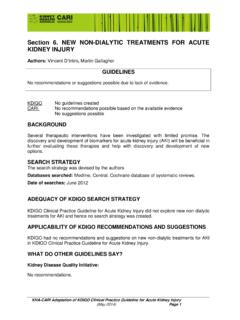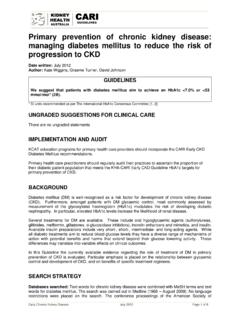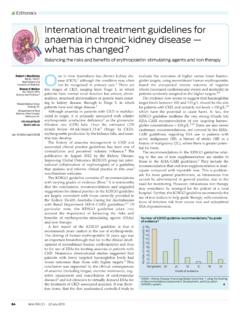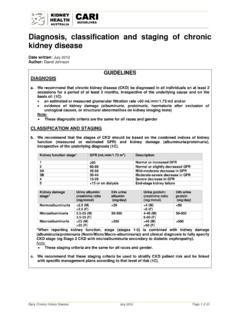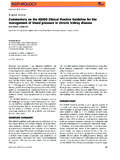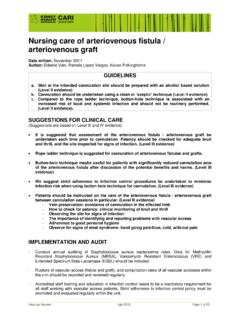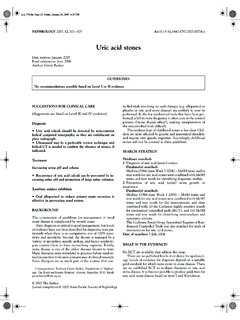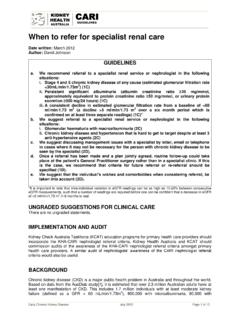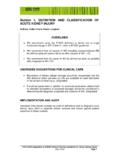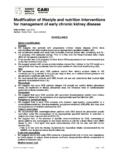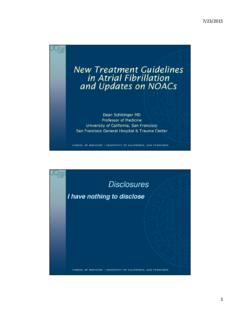Transcription of KHA-CARI Guideline: Peritonitis treatment and prophylaxis
1 Bs_bs_banner Nephrology 19 (2014) 69 71. Original Article KHA-CARI Guideline: Peritonitis treatment and prophylaxis AMANDA WALKER,1 KYM BANNISTER,2 CHARLES GEORGE,3 DAVID MUDGE,6 MAHA YEHIA,7 MAUREEN LONERGAN5. and JOSEPHINE CHOW4. 1. Department of Nephrology, Royal Children's Hospital, Melbourne, Victoria, 2 Renal Unit, Royal Adelaide Hospital, Adelaide, South Australia, 3 Renal Of ce, Concord Repatriation General Hospital, 4 Renal Service, South Western Sydney Local Health District, Sydney, and 5 Renal Department, The Wollongong Hospital, Wollongong, New South Wales, 6 Department of Nephrology, Princess Alexandra Hospital, Brisbane, Queensland, Australia; and 7 Department of Renal Medicine, Auckland City Hospital, Auckland, New Zealand Correspondence: Dr Amanda Walker, Department of Nephrology, Royal Children's Hospital, 50 Flemington Road, Parkville, Vic.
2 3052, Australia; Department of Paediatrics, Monash University, Clayton, Vic. 3168, Australia. Email: Accepted for publication 8 August 2013. Accepted manuscript online 15 August 2013. GRADING OF EVIDENCE Peritonitis and when ESI and Peritonitis occur together, cath- eter removal occurs in approximately 50% of These guidelines were developed before the uptake of the GRADE framework by the KHA-CARI guidelines organiza- tion. Accordingly, the writers have followed an adapted 1. The in uence of peritoneal dialysis systems version of the NHMRC evidence rating system published in and solutions on the incidence of Peritonitis and A description of the ratings applied to the evidence is catheter-related infections shown in Table 1. Guideline Recommendations are based on Guideline recommendations Level I or II evidence and Suggestions for Clinical Care are based on Level III or IV evidence.
3 A. Disconnect systems of continuous ambulatory peritoneal dialysis (CAPD) result in lower rates of Peritonitis than spike' systems and this older system should no longer be SCOPE OF GUIDELINE used (Evidence level I). b. Twin bag systems have lower rates of Peritonitis than This guideline addresses issues relevant to the development, Y-disconnect systems and are recommended as the preferred prevention and management of Peritonitis and catheter- CAPD technique (Evidence level I). related infections in peritoneal dialysis patients. c. There is insufficient high level evidence (one adequate small RCT only) to support a difference in Peritonitis rates when biocompatible fluids are used compared with standard Peritonitis AND CATHETER-RELATED dextrose solutions in PD patients (Evidence level II).
4 INFECTIONS IN PERITONEAL. DIALYSIS PATIENTS. Suggestions for clinical care Recurrent or severe exit site infections (ESI) and Peritonitis are a problem with peritoneal dialysis (PD) and represent the The choice of APD or CAPD regimens in PD patients major causes of Tenckhoff catheter removal and PD tech- should not be influenced by a possible effect on Peritonitis nique failure. Peritonitis is the most common complication of rates. PD. Up to one-third of all PD Peritonitis episodes lead to The choice of conventional or biocompatible PD solu- hospitalization2 and 5 10% of cases end in patient tions should not be unduly influenced by potential benefits ESI are associated with a greatly increased risk of subsequent in Peritonitis rates until stronger evidence becomes available. 2013 Asian Paci c Society of Nephrology 69.
5 A Walker et al. Table 1 Designation of levels of evidence Suggestions for clinical care Level of evidence Study design The appropriate timing for reinsertion of a peritoneal I Evidence obtained from a systematic review of all dialysis catheter that has been removed because of Peritonitis relevant randomized controlled trials is not known. II Evidence obtained from at least one properly Anecdotal recommendations range from simultaneous designed randomized controlled trial removal and reinsertion to waiting for a minimum of three III Evidence obtained from comparative studies (cohort weeks after removal before reinsertion. studies, case control studies, pseudo-randomized controlled trials etc.). IV Evidence obtained from case series (either post-test 4. Type of peritoneal dialysis catheter or pre-test/post-test).
6 Guideline recommendations a. No peritoneal dialysis catheter has proven to be superior to the two-cuff standard Tenckhoff catheter in the prevention 2. Management of peritoneal dialysis-associated of Peritonitis (Evidence level II). Peritonitis in adults and children b. Coiled-tipped catheters are associated with increased risk of technique failure as compared with straight-tipped cath- Guideline recommendations eters (Evidence level II). a. In peritoneal dialysis patients with a provisional diagnosis of Peritonitis , treatment should commence with a combina- 5. Technique of insertion of peritoneal tion of intraperitoneal antibiotics that will adequately cover dialysis catheter Gram-positive and Gram-negative organisms. Once bacterial diagnosis is made, then a change to appropriate antibiotic Guideline recommendations should be made.
7 treatment should be of adequate duration a. Laparoscopy for insertion of peritoneal dialysis catheters to reduce recurrence (Evidence level II). has been shown to have similar complication rates to lapa- rotomy (Evidence level I). Suggestions for clinical care b. Peritoneoscopic insertion of peritoneal dialysis catheters may be superior to dissective insertion in the prevention of Where local or international guidelines are available they Peritonitis , leaking of peritoneal dialysis fluid around the cuff should be used to guide therapy. and technique failure (Evidence level II). Peritoneal dialysate effluent should be collected and pro- cessed in appropriate manner to ensure culture-negative epi- sodes account for <20% of all PD-associated Peritonitis . Suggestions for clinical care While there is no good evidence to support specific anti- Peritoneal dialysis catheters should be inserted by experi- biotic choice, empiric intraperitoneal therapy should con- enced operators working as part of a multidisciplinary team sider local microbiological resistance profiles and cover as this is associated with low reported infectious complica- Gram-positive and Gram-negative bacteria.
8 Gram-positive tion rates. organisms may be covered by vancomycin or a cephalo- sporin and Gram-negative organisms by a third generation cephalosporin or aminoglycoside. 6. Prophylactic antibiotics for insertion of When there is a suitable alternative, aminoglycoside use peritoneal dialysis catheters should be limited to avoid their adverse effects of Guideline recommendations nephrotoxicity and ototoxicity. Dual antibiotic therapy is indicated for Pseudomonas spp. a. Intravenous antibiotic prophylaxis should be used prior to Peritonitis . peritoneal dialysis catheter insertion to reduce the risk of early Peritonitis (Evidence level I). b. Vancomycin, cephalosporins and gentamicin have dem- 3. Catheter removal, adjunct therapies and timing onstrated effectiveness in reducing the risk of Peritonitis of reinsertion of peritoneal dialysis catheter (Evidence level II).
9 After Peritonitis Guideline recommendations Suggestions for clinical care a. The use of antibiotics with catheter replacement is Protocols for antibiotic prophylaxis prior to catheter superior to antibiotics with urokinase to treat peritoneal insertion should be guided by local infectious disease guide- dialysis-associated Peritonitis (Evidence level II). lines and local bacterial resistance profiles. Vancomycin use 2013 Asian Paci c Society of Nephrology 70. KHA-CARI Guideline: Peritonitis should be restricted to avoid emerging vancomycin-resistant Suggestions for clinical care enterococci (VRE) and Staphylococcus aureus (VRSA). Vancomycin use should be guided by the infectious disease Effective antibiotic therapy is recommended for perito- neal dialysis catheter-related infection.
10 guidelines of individual treatment units. Either intraperitoneal or oral antibiotics may be considered. 7. Timing of commencement of peritoneal dialysis following catheter insertion 10. prophylaxis for exit site/tunnel infections Guideline recommendations using mupirocin No recommendation possible based on Level I or II evidence. Guideline recommendations a. Prophylactic therapy using mupirocin ointment, espe- Suggestions for clinical care cially for S. aureus carriage (intranasally or at the exit site) is Commencement of peritoneal dialysis should preferably recommended to decrease the risk of S. aureus catheter exit be delayed until 14 days after catheter placement. This is to site/tunnel infections and Peritonitis (Evidence level I). reduce the risk of dialysate leakage, subsequent infections as b.
